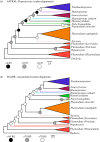The polyphyly of Plasmodium: comprehensive phylogenetic analyses of the malaria parasites (order Haemosporida) reveal widespread taxonomic conflict
- PMID: 29892372
- PMCID: PMC5990803
- DOI: 10.1098/rsos.171780
The polyphyly of Plasmodium: comprehensive phylogenetic analyses of the malaria parasites (order Haemosporida) reveal widespread taxonomic conflict
Abstract
The evolutionary relationships among the apicomplexan blood pathogens known as the malaria parasites (order Haemosporida), some of which infect nearly 200 million humans each year, has remained a vexing phylogenetic problem due to limitations in taxon sampling, character sampling and the extreme nucleotide base composition biases that are characteristic of this clade. Previous phylogenetic work on the malaria parasites has often lacked sufficient representation of the broad taxonomic diversity within the Haemosporida or the multi-locus sequence data needed to resolve deep evolutionary relationships, rendering our understanding of haemosporidian life-history evolution and the origin of the human malaria parasites incomplete. Here we present the most comprehensive phylogenetic analysis of the malaria parasites conducted to date, using samples from a broad diversity of vertebrate hosts that includes numerous enigmatic and poorly known haemosporidian lineages in addition to genome-wide multi-locus sequence data. We find that if base composition differences were corrected for during phylogenetic analysis, we recovered a well-supported topology indicating that the evolutionary history of the malaria parasites was characterized by a complex series of transitions in life-history strategies and host usage. Notably we find that Plasmodium, the malaria parasite genus that includes the species of human medical concern, is polyphyletic with the life-history traits characteristic of this genus having evolved in a dynamic manner across the phylogeny. We find support for multiple instances of gain and loss of asexual proliferation in host blood cells and production of haemozoin pigment, two traits that have been used for taxonomic classification as well as considered to be important factors for parasite virulence and used as drug targets. Lastly, our analysis illustrates the need for a widespread reassessment of malaria parasite taxonomy.
Keywords: Plasmodium; base composition bias; malaria; phylogeny; polyphyly.
Conflict of interest statement
The authors declare that they have no competing interests.
Figures




Similar articles
-
Phylogeny of haemosporidian blood parasites revealed by a multi-gene approach.Mol Phylogenet Evol. 2016 Jan;94(Pt A):221-31. doi: 10.1016/j.ympev.2015.09.003. Epub 2015 Sep 11. Mol Phylogenet Evol. 2016. PMID: 26364971
-
Evolutionary lability of host associations promotes phylogenetic overdispersion of co-infecting blood parasites.J Anim Ecol. 2019 Dec;88(12):1936-1949. doi: 10.1111/1365-2656.13089. Epub 2019 Sep 9. J Anim Ecol. 2019. PMID: 31408525
-
Diverse sampling of East African haemosporidians reveals chiropteran origin of malaria parasites in primates and rodents.Mol Phylogenet Evol. 2016 Jun;99:7-15. doi: 10.1016/j.ympev.2016.03.004. Epub 2016 Mar 12. Mol Phylogenet Evol. 2016. PMID: 26975691
-
Evolutionary ecology, taxonomy, and systematics of avian malaria and related parasites.Acta Trop. 2020 Apr;204:105364. doi: 10.1016/j.actatropica.2020.105364. Epub 2020 Jan 30. Acta Trop. 2020. PMID: 32007445 Review.
-
Origin and diversity of malaria parasites and other Haemosporida.Trends Parasitol. 2023 Jul;39(7):501-516. doi: 10.1016/j.pt.2023.04.004. Epub 2023 May 16. Trends Parasitol. 2023. PMID: 37202254 Review.
Cited by
-
Sporogony of four Haemoproteus species (Haemosporida: Haemoproteidae), with report of in vitro ookinetes of Haemoproteus hirundinis: phylogenetic inference indicates patterns of haemosporidian parasite ookinete development.Parasit Vectors. 2019 Aug 28;12(1):422. doi: 10.1186/s13071-019-3679-1. Parasit Vectors. 2019. PMID: 31462309 Free PMC article.
-
Molecular detection of Trypanosoma spp. and Hepatocystis parasite infections of bats in Northern Nigeria.Parasitology. 2022 Sep;149(11):1460-1467. doi: 10.1017/S0031182022000890. Epub 2022 Jul 13. Parasitology. 2022. PMID: 35822266 Free PMC article.
-
The African origin of Plasmodium vivax.FEMS Microbiol Rev. 2022 Jul 20;46(4):fuac015. doi: 10.1093/femsre/fuac015. FEMS Microbiol Rev. 2022. PMID: 35767876 Free PMC article. No abstract available.
-
An Ecologically Framed Comparison of The Potential for Zoonotic Transmission of Non-Human and Human-Infecting Species of Malaria Parasite.Yale J Biol Med. 2021 Jun 30;94(2):361-373. eCollection 2021 Jun. Yale J Biol Med. 2021. PMID: 34211355 Free PMC article. Review.
-
Using a GTR+Γ substitution model for dating sequence divergence when stationarity and time-reversibility assumptions are violated.Bioinformatics. 2020 Dec 30;36(Suppl_2):i884-i894. doi: 10.1093/bioinformatics/btaa820. Bioinformatics. 2020. PMID: 33381826 Free PMC article.
References
-
- Souto RP, Fernandes O, Macedo AM, Campbell DA, Zingales B. 1996. DNA markers define two major phylogenetic lineages of Trypanosoma cruzi. Mol. Biochem. Parasitol. 83, 141–152. (doi:10.1016/S0166-6851(96)02755-7) - DOI - PubMed
-
- Suzuki Y, Gojobori T. 1997. The origin and evolution of Ebola and Marburg viruses. Mol. Biol. Evol. 14, 800–806. (doi:10.1093/oxfordjournals.molbev.a025820) - DOI - PubMed
-
- Gao F, et al. 1999. Origin of HIV-1 in the chimpanzee Pan troglodytes troglodytes. Nature 397, 436–441. (doi:10.1038/17130) - DOI - PubMed
-
- Rambaut A, Robertson DL, Pybus OG, Peeters M, Holmes EC. 2001. Human immunodeficiency virus: phylogeny and the origin of HIV-1. Nature 410, 1047–1048. (doi:10.1038/35074179) - DOI - PubMed
-
- Zwickl DJ, Hillis DM. 2002. Increased taxon sampling greatly reduces phylogenetic error. Sys. Biol. 51, 588–598. (doi:10.1080/10635150290102339) - DOI - PubMed
Associated data
LinkOut - more resources
Full Text Sources
Other Literature Sources

